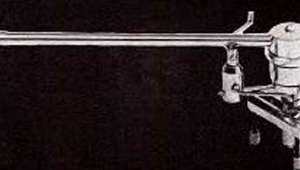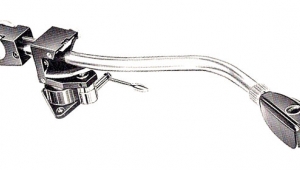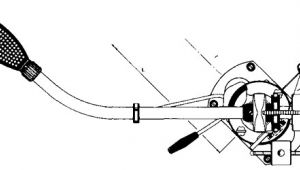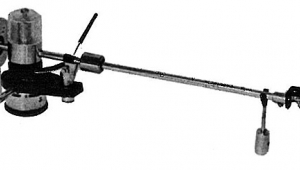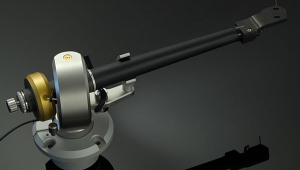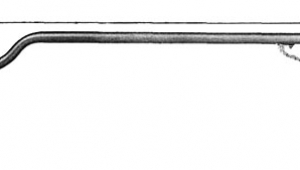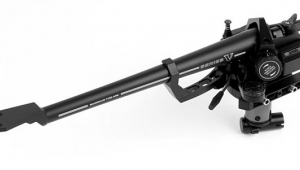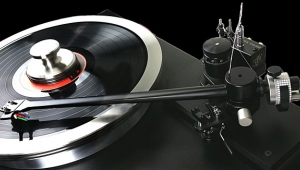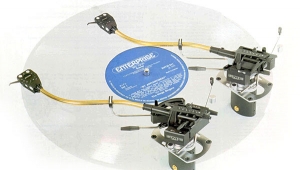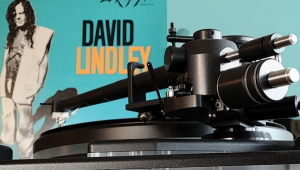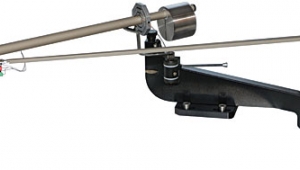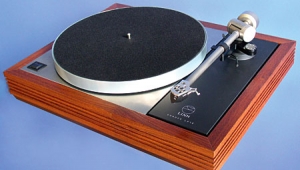| Columns Retired Columns & Blogs |
Naim ARO tonearm & Armageddon turntable power supply Page 4
Switching over to the full-blown Linn, we listened to about 32 bars before staring at each other in disbelief: there was much less detail and sparkle on the top, and the pace didn't brim as much with vim, but the Linn had, perhaps, an extra octave of bass! We switched back to the Naim unit to check. Yep, it really rocked more, and there sure was a lot more overtone information. What about the bass? It was tuneful, well differentiated, tight, and quite punchy—nothing to complain about. We switched back to the Linn. No doubt about it, it had tons more bass extension. The opulence of Vaughan's voice, as deep in places as any tenor's, also came through in a richer, more convincing way.
Which was more accurate? I find it hard to say. The snap and surge of the rhythms that propel the song along were, I think, better served by the Armageddoned Linn. Yet Vaughan's voice, all honey and smoke, sounds more as it really does on the Linn.
We switched to McCoy Tyner's Song of the New World (Milestone MSP9049), and I cued-up "Afro Blue"—I've always liked Tyner's large ensembles best of all his work as a leader, and this tune, with 15 musicians committed to creating the world itself, stands out as a favorite. We listened to the Linn first, and the massed brasses (three trumpets, two trombones, three French horns, euphonium, and tuba) had a huge, warm presence and an unforced presentation. Switching over to the Naim rig, we were first struck by the percussion—this was a world whose heartbeat had primacy—Alphonse Mouzon and Sonny Morgan drove the ensemble. When the brasses entered it was their punch and blat that we noticed. Captivated, we listened through the two rigs again. Again, we enjoyed both and, again, we were stunned at the differences in presentation.
We listened all evening, each of us pulling out old favorites, both of us marveling at the differences revealed. I won't speak for John; since he gets final edit on this, he's perfectly capable of adding anything he feels I've left unsaid. But I consistently found the pace and energetic presentation of the Armageddon/ARO equipped LP12 beguiling. I was drawn into the music through the ebullient rhythmic underpinning. I also preferred the amount of detail and life that came through this rig—especially in the upper frequencies. In comparison, the Linn system seemed to keep the music at a further remove. On the other hand, the Naim system did lack the Linn's mellower—and, I (and JA) think, more true-to-life—presentation of the midrange. There was a hardness, as in the hardness of the consonant cluster "ck", to the Naim in the vocal region. Truly expressive singers, such as Sarah Vaughan and Ian Tyson, communicated more directly when their discs were played back by the Linn.
Then there was the matter of bottom-end extension. The Linn just had a lot more of it—a lot more. This didn't mean that the Armageddon/ARO combo sounded deficient down below. It didn't; it sounded punchy and focused, with the bass integrated organically with the rest of the music. But play the same disc on the Linn and it was undeniable, the deepest bass was far more present through the Linn.
John was reminded of a story he heard about the development of bass-guitar amplification in the '60s. It seems that the amp makers kept trying to improve bass response and integration by extending the bottom-most response of their speakers, but they kept getting ill-defined mush rather than deep, articulate tones. Finally, it occurred to someone that the key was to limit low-frequency response rather than extend it, thus beginning an era of punchy, articulate, but bandwidth-limited, bass amplification. I suspect he's right, that Naim has chosen control over extension.
So?
Which is better? I'm going to waffle here. I'd like a unit offering the Linn's midrange ease and low-end extension coupled with the swinging pace and upper-end air of the Naim. Or, as John wistfully put it toward the end of our listening session, "Wouldn't it be great to own both—that way you could get two hits off of every LP!"
I can't really justify that approach, so I think—for the moment—that I'll content myself with the Naim rig. I really am quite chuffed with its presentation of the rhythmic core of music. That's important to me in a way that the Linn's bass extension is, ultimately, not. Immediacy is another trait I value in musical reproduction, and the Naim products have that in spades—another big plus. I suspect that JA—and many other audiophiles—would choose otherwise. 'S okay, both are at the top of the heap, in my opinion, despite vast differences in presentation. Everybody's a winner with choices like these.
I'd love to conclude by telling anyone interested in high-end analog reproduction to run out and try the comparison themselves, but these days, I doubt there are even three stores in the country that could offer such a comparison—so I don't know what to say. Other than that both the Naim Armageddon and the ARO have increased my appreciation of my favorite discs, and if that sounds like a good thing to you, you should definitely hear what yours sound like through them.
Footnote 1: What's in a naim? Few people realize that the Naim ARO derives its name from what its armtube is made of: specifically, an aluminum-alloy tube originally designed as the shaft for competition-grade arrows. Chris West: "We were looking for a rigid, uniform, straight material for the tonearm, and so we sourced it from the manufacturer of what were, at the time, the best arrows for Olympic competition. Those arrows have to be incredibly straight—they check the shafts with a laser—so we were assured of a consistently close tolerance material."—Wes Phillips
- Log in or register to post comments
